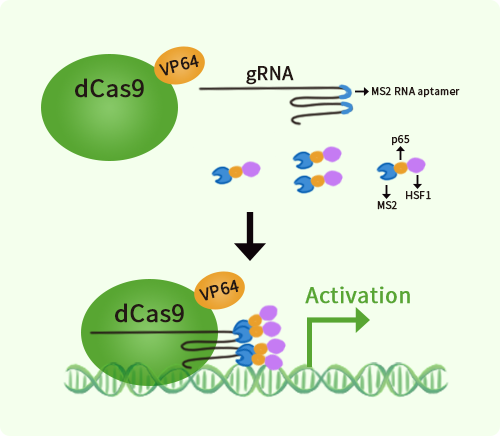Mouse Mycbp2 activation kit by CRISPRa
CAT#: GA211887
Mycbp2 CRISPRa kit - CRISPR gene activation of mouse MYC binding protein 2, E3 ubiquitin protein ligase
Find the corresponding CRISPRi Inhibitor Kit
USD 1,657.00
2 Weeks*
Size
Other products for "Mycbp2"
Specifications
| Product Data | |
| Format | 3 gRNAs (5ug each), 1 scramble ctrl (10ug) and 1 enhancer vector (10ug) |
| Symbol | Mycbp2 |
| Locus ID | 105689 |
| Kit Components | GA211887G1, Mycbp2 gRNA vector 1 in pCas-Guide-GFP-CRISPRa GA211887G2, Mycbp2 gRNA vector 2 in pCas-Guide-GFP-CRISPRa GA211887G3, Mycbp2 gRNA vector 3 in pCas-Guide-GFP-CRISPRa 1 CRISPRa-Enhancer vector, SKU GE100056 1 CRISPRa scramble vector, SKU GE100077 |
| Disclaimer | These products are manufactured and supplied by OriGene under license from ERS. The kit is designed based on the best knowledge of CRISPRa SAM technology. The efficiency of the activation can be affected by many factors, including nucleosome occupancy status, chromatin structure and the gene expression level of the target, etc. |
| Reference Data | |
| RefSeq | NM_207215 |
| Synonyms | AU023734; AW107953; AW546647; C130061D10Rik; Pam; Phr1; R75243 |
| Summary | Atypical E3 ubiquitin-protein ligase which specifically mediates ubiquitination of threonine and serine residues on target proteins, instead of ubiquitinating lysine residues (By similarity). Shows esterification activity towards both threonine and serine, with a preference for threonine, and acts via two essential catalytic cysteine residues that relay ubiquitin to its substrate via thioester intermediates (By similarity). Interacts with the E2 enzymes UBE2D1, UBE2D3, UBE2E1 and UBE2L3 (By similarity). Plays a key role in neural development, probably by mediating ubiquitination of threonine residues on target proteins (By similarity). Involved in different processes such as regulation of neurite outgrowth, synaptic growth, synaptogenesis and axon degeneration (PubMed:14729956, PubMed:17901218, PubMed:18031680). Required for the formation of major central nervous system axon tracts (PubMed:17901218, PubMed:18031680). Required for proper axon growth by regulating axon navigation and axon branching: acts by regulating the subcellular location and stability of MAP3K12/DLK (PubMed:18031680). Required for proper localization of retinogeniculate projections but not for eye-specific segregation (PubMed:19371781, PubMed:21324225). Regulates axon guidance in the olfactory system (PubMed:23525682). Involved in Wallerian axon degeneration, an evolutionarily conserved process that drives the loss of damaged axons: acts by promoting destabilization of NMNAT2, probably via ubiquitination of NMNAT2 (PubMed:23665224). Catalyzes ubiquitination of threonine and/or serine residues on NMNAT2, consequences of threonine and/or serine ubiquitination are however unknown (By similarity). Regulates the internalization of TRPV1 in peripheral sensory neurons (PubMed:21098484). May mediate ubiquitination and subsequent proteasomal degradation of TSC2/tuberin (By similarity). Independently of the E3 ubiquitin-protein ligase activity, also acts as a guanosine exchange factor (GEF) for RAN in neurons of dorsal root ganglia (PubMed:26304119). May function as a facilitator or regulator of transcriptional activation by MYC (By similarity). Acts in concert with HUWE1 to regulate the circadian clock gene expression by promoting the lithium-induced ubiquination and degradation of NR1D1 (PubMed:20534529).[UniProtKB/Swiss-Prot Function] |
Documents
| Product Manuals |
| FAQs |
| SDS |
Resources
{0} Product Review(s)
0 Product Review(s)
Submit review
Be the first one to submit a review
Product Citations
*Delivery time may vary from web posted schedule. Occasional delays may occur due to unforeseen
complexities in the preparation of your product. International customers may expect an additional 1-2 weeks
in shipping.






























































































































































































































































 Germany
Germany
 Japan
Japan
 United Kingdom
United Kingdom
 China
China
